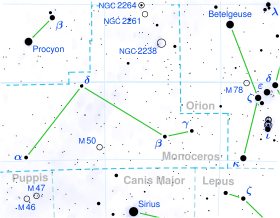ε Monocerotis, Latinised as Epsilon Monocerotis, is the Bayer designation of a binary star system in the equatorial constellation Monoceros. Its location is a guide for sky navigation toward the Rosette Nebula.[11]
Quick facts Observation data Epoch J2000 Equinox, Apparent magnitude (V) ...
ε Monocerotis
Location of ε Monocerotis (circled red) |
Observation data
Epoch J2000 Equinox |
| Constellation |
Monoceros |
| ε Mon A |
| Right ascension |
06h 23m 46.08471s[1] |
| Declination |
4° 35′ 34.3153″[1] |
| Apparent magnitude (V) |
4.39[2] |
| ε Mon B |
| Right ascension |
06h 23m 46.48292s[1] |
| Declination |
4° 35′ 45.2307″[1] |
| Apparent magnitude (V) |
6.72[2] |
| Characteristics |
| ε Mon A |
| Spectral type |
A5 IV[3] |
| U−B color index |
+0.14[4] |
| B−V color index |
+0.20[4] |
| ε Mon B |
| Spectral type |
F5 V[3] |
| U−B color index |
−0.05[5] |
| B−V color index |
+0.45[5] |
| Astrometry |
|---|
| ε Mon A |
|---|
| Radial velocity (Rv) | +13.10[6] km/s |
| Proper motion (μ) | RA: −22.06[1] mas/yr
Dec.: +10.91[1] mas/yr |
| Parallax (π) | 26.67±0.90 mas[1] |
| Distance | 122 ± 4 ly
(37 ± 1 pc) |
| Absolute magnitude (MV) | 1.52[2] |
| ε Mon B |
|---|
| Radial velocity (Rv) | +12.40[6] km/s |
| Proper motion (μ) | RA: −21.86[1] mas/yr
Dec.: +11.35[1] mas/yr |
| Parallax (π) | 26.95±0.99 mas[1] |
| Distance | 121 ± 4 ly
(37 ± 1 pc) |
| Absolute magnitude (MV) | +3.88[2] |
| Details |
|---|
| ε Mon A |
|---|
| Mass | 2.04[7] M☉ |
| Radius | 2.5[8] R☉ |
| Luminosity | 25[7] L☉ |
| Surface gravity (log g) | 3.95[9] cgs |
| Temperature | 7,923[9] K |
| Metallicity [Fe/H] | −0.11[10] dex |
| Rotational velocity (v sin i) | 149[7] km/s |
| ε Mon B |
|---|
| Mass | 1.16[8] M☉ |
| Radius | 1.1[8] R☉ |
| Luminosity | 2.39[2] L☉ |
| Surface gravity (log g) | 3.95[9] cgs |
| Temperature | 7,923[9] K |
| Rotational velocity (v sin i) | 25[3] km/s |
| Other designations |
|---|
| ε Mon, 8 Monocerotis, CCDM J06237+0436, WDS J06238+0436 |
| ε Mon A: BD+04°1236, FK5 244, GC 8240, HD 44769, HIP 30419, HR 2298, SAO 113810 |
| ε Mon B: BD+04°1237, FK5 244, GC 8241, HD 44770, HIP 30422, HR 2299, SAO 113811 |
| Database references |
|---|
| SIMBAD | data |
|
|---|
| SIMBAD | data |
Close
The white-hued primary component has a stellar classification of A5 IV,[3] suggesting it is an aging subgiant star. Its apparent magnitude is 4.39[2] and it is approximately 122 light years away based on parallax.[1] It is reportedly a spectroscopic binary with a period around 331 days.[12]
The B component, at a separation of around 12.3",[12] is a yellow-white hued F-type main-sequence star of class F5 V[3] and an apparent magnitude of 6.72.[2]

